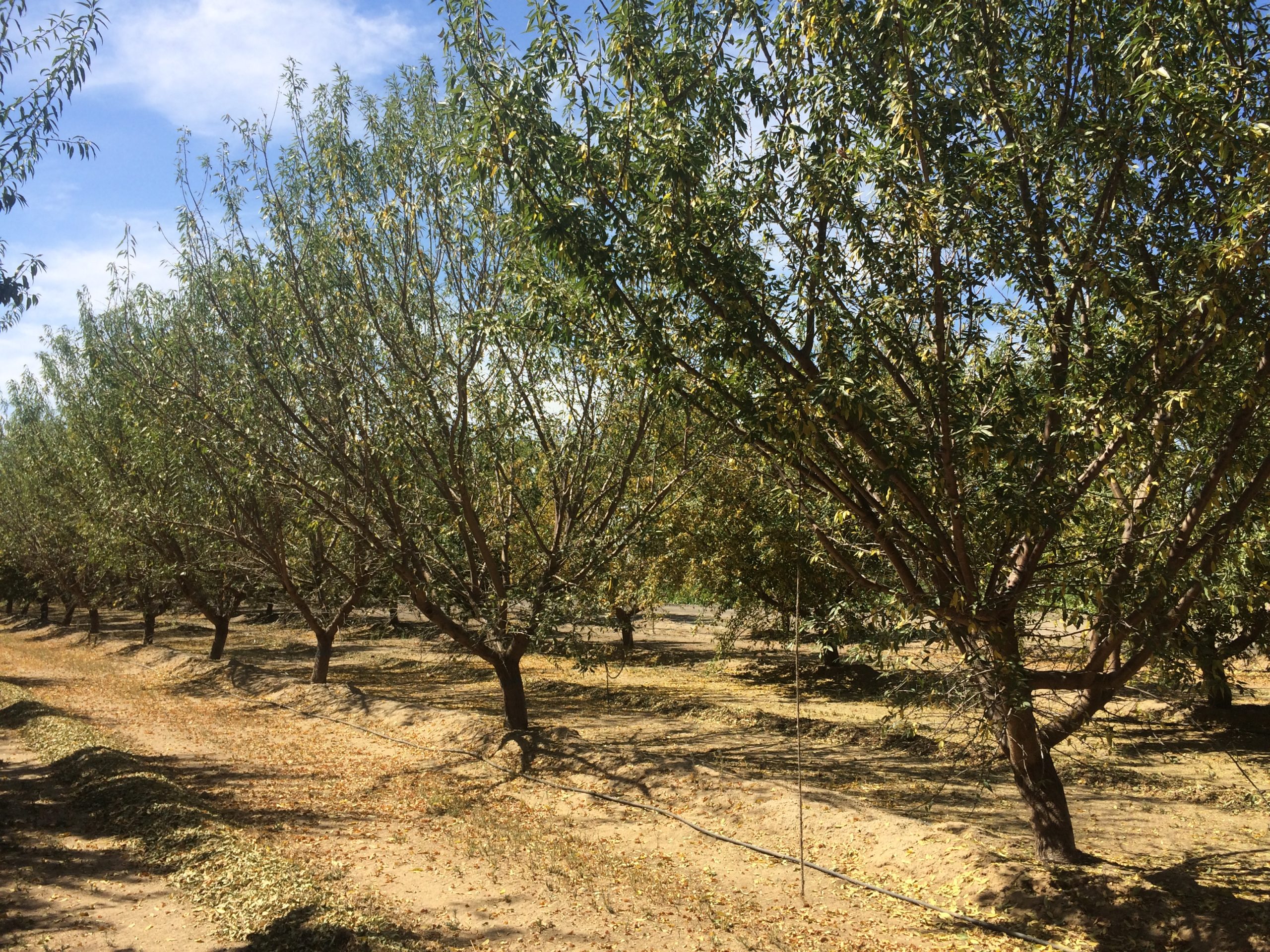Drought years are tough. Limited water supplies create several challenges that impact the current and future year’s crop. Several articles have been constructed to help manage almond orchards with limited water supplies, but as harvest starts, focus needs to shift to post-harvest management of the orchards.
Many orchards relied on groundwater at some point through this year. This may have been sourced directly from a well on the property, or from wells within an irrigation district. Groundwater often contains elevated levels of salt, in particular sodium and chloride. These salts accumulate in the soil from the irrigations that occur during the season. Due to almond roots generally excluding salts, salt levels within the soil could climb as high as 10-15 times the concentration of the irrigation water within a single season. These higher levels of salt will impact growth and productivity as well as lead to tissue toxicity and leaf loss.
To manage these salts, they need to be removed from the active rootzone of the tree. Salinity management for various soil types have been described previously for sandy and finer texture soils. These programs rely on winter leaching to reduce the salinity levels within the active rootzone of the tree. This process, however, can be improved by taking actions in the post-harvest to increase soil moisture levels. At this time of year, a leaching fraction should be added to each water applications to increase soil moisture levels. An increase of 15-20% of the irrigation duration should be sufficient. This additional water will refill the soil profile during this period, increasing the effectiveness of leaching by winter rains.
The value of applying a leaching fraction in the post-harvest is greater than leaching fractions applied earlier in the season. This is due to the irrigation practices associated with harvest – a time which water applications are reduced. Once water applications are reduced for hull-split and harvest, the tree and soil dynamics will pull the deeper moisture into the rootzone, bringing in the dissolved salts. During the post-harvest, there are no practices that would interfere with the building of stored soil moisture. Furthermore, leaching fractions require less time to apply due to reduced irrigation demand.
After refilling the soil profile throughout the fall, additional water may be needed to complete the leaching program. If significant rainfall isn’t received by Christmas, a winter irrigation will be needed. The amount of water depends on the quality of water, the levels of soil salinity, soil type, and irrigation system. After having these variables accounted for, water needs can be estimated more precisely. Based on personal experience, generally, after the profile is filled, about 6-10” of additional water are needed for sandier soils, while 10-15” are needed for loams and clay soils. This water should be applied in 0.5-1” increments, allowing the soil to drain between each irrigation. The amount of rainfall received can be subtracted from these amounts. More on winter leaching programs can be found in this article.



Joel Taylor
August 21, 2021David, if, for example, almonds require approx 5.5 AF (ETc), and a grower over a season applies only 3.0 AF, that deep percolation = 0 AF? Hence, no leaching, increased sodium in the soil stack, increased dispersion? Isn’t soil sustainability and soil health not so much about how much water is available, but how it’s deployed on a per acre basis? If the amount deployed per acre is < (Crop ETc + Field Capacity) then there's no water percolating out of the soil stack, which means no leaching and all the sodium is being carried via soil cation exchange. In effect, the soil is getting turned into a salt block?
Davidd
August 25, 2021Dear Joel,
If less water than plant demand is applied, then you are correct, no leaching will occur. If this process continues for several months/years, depending on water quality, the soil salinity levels will increase, leading to toxic levels which will hinder plant growth. Often, soil salts are pushed below the rootzone by winter rainfall, but in drought years, this doesn’t occur.
Attempting to leach in-season with leaching fractions isnt really possible due to how we farm and crop water demand. In-turn, we should leach when the water applied is more effective – when plant water demand drops, rainfall occurs, and farming practices do not interfere. This is the essence of the article – attempting to leach in-season is less effective then a post-harvest/dormant leaching program, and it should start in the post-harvest period. If there is no water available for leaching in the post-harvest or dormant, the only other option is to wait for the rain.
David
Joel Taylor
October 4, 2021Do you believe that this holds true for Westlands? That winter rains and a moderate 20% overwatering for some number of weeks will offset the accumulated salts and solids of the prior growing season?